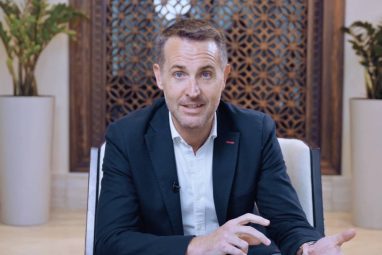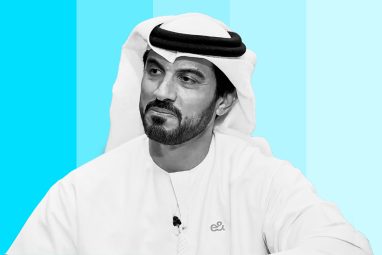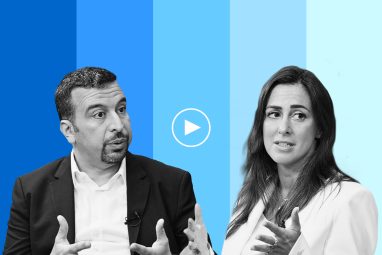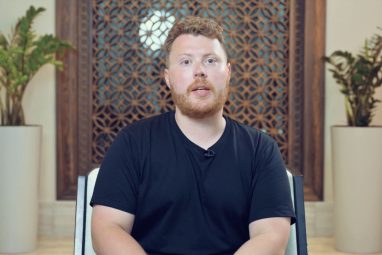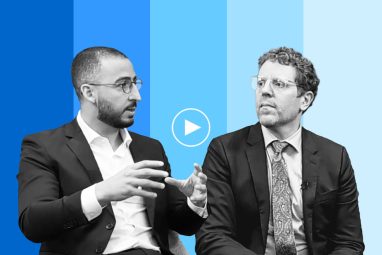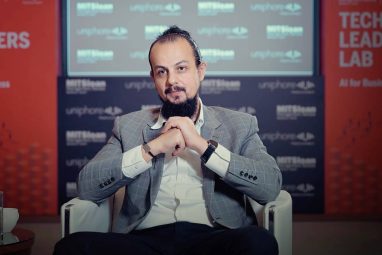Topics
What to Read Next
- Why You Can’t Hire for Skills Without a Skills-Based Culture
- Identity-based Attacks Account for 60% of Leading Cyber Threats, Report Finds
- CERN and Pure Storage Partner to Power Data Innovation in High-Energy Physics
- Lessons Learned From Outside Innovators
- CyberArk Launches New Machine Identity Security Platform to Protect Cloud Workloads
- How Emerging Technologies are Transforming Collaboration in the Middle East’s Construction Sector
In this episode Dr. Bernd van Linder, CEO of Commercial Bank of Dubai, and Mohammad Khan, MD & Partner at BCG, offer real-world insights into how banks are moving beyond pilot programs and embedding GenAI into their core operations.
In the third episode of More Than Meets the AI—a thought leadership series by MIT Sloan Management Review Middle East in collaboration with Boston Consulting Group (BCG)—GenAI and the Next Generation of Digital Banking, the spotlight turns to how generative AI (GenAI) is already reshaping financial services in meaningful ways.
Suraya Turk, Managing Partner at Legal Circle, hosts a candid and insightful discussion with Dr. Bernd van Linder, CEO of Commercial Bank of Dubai, and Mohammad Khan, Managing Director & Partner at BCG. Together, they unpack how banks are moving beyond pilot programs and actively leveraging GenAI to personalize customer experiences, improve operational efficiency, and support more informed, data-driven decisions.
From credit analysis and transaction monitoring to regulatory compliance and virtual customer service, the conversation surfaces real-world use cases—and the critical need for robust governance. Both leaders emphasize that while GenAI is powerful, it’s not the technology alone that will drive transformation. It’s the people, leadership, and culture behind it that will define success.
With insights from both the strategic and implementation frontlines, this episode explores the intersection of banking, AI, and the future of work in financial services—offering a clear-eyed view of what’s next and what it takes to get there.
Transcript
Suraya Turk: Welcome. It’s a pleasure to have you both. Today we’re going to explore the concept of GenAI in digital banking, in the financial sector, and I’d love to start with Mr. Mohammad. So Mohammad, there’s a buzzword now about GenAI and what’s happening in the financial sector. Can you tell us what you see, but also what you see is going to happen in the next few years in this sector?
Mohammad Khan: Yeah. Well, look, thank you for having us. Look, absolutely, GenAI—right now, I don’t think you can complete a meeting without hearing the words, right? So it’s almost mandatory. We do believe it’s going to profoundly shift what we’re seeing in banking, and this is borne out also by our research. We did a survey quite recently of many CEOs in different banks, and over 85% said this would profoundly shift how their business operates.
The way I would characterize it is along two areas. So if we take a customer lens, it will dramatically shift the experience customers have when they interact with their banks. The interactions will be more personalized, they’ll be faster, they’ll be more accurate. If I think of it from a bank perspective, it will enable banks to run much more efficiently and much more effectively.
So if we talk about an example, when a customer calls a bank, in the future, the bank will know why they’re calling and potentially already have a solution lined up. And as they conclude the interaction, they may also be able to suggest a different product or offering that suits the customer’s needs.
Suraya Turk: That’s an interesting perspective, because we’ll talk to Dr. Bernd about that in a minute, but there’s a few things that you said there about personalizing the experience for the customers, understanding what their needs are, and addressing those more efficiently and effectively. Would you agree with the statement that he’s made? And how is that going to be possible with the implementation of GenAI?
Dr. Bernd van Linder: I do agree with everything that Mohammad has said. The impact on customer experience and operational efficiency within the bank—probably within every company in every industry—will be absolutely massive.
I think there’s a third element to that, and that’s the productivity of our workforce. We started a pilot—we were one of the pilot companies in the region with Microsoft Copilot some time ago—and the impact it has had already on the productivity of our staff is significant in terms of meeting minutes, emails, summarizing documents. All of that already has a great impact.
So it’s customer experience, operational efficiency, and I would add workforce productivity as well.
Suraya Turk: Interesting, fantastic. But Mohammad, I’d love to hear your thoughts on and continuing from the point Dr. Bernd made about productivity of staff and more efficiencies. But then what impact is that going to have, for example, on the number of staff that you now need? Are there going to be more redundancies? Is AI now going to replace humans and the manpower and resources? What are your thoughts on that in particular?
Mohammad Khan: So it’s a very important question, and I think the answer is somewhere in the middle. So I think we’ve heard a lot about massive displacement of jobs. We don’t believe that will be the case.
I think, as Dr. Bernd said, a lot of institutions right now are leveraging GenAI to augment people—so how to make them more effective, how to make them more efficient, more productive. And that’s where we see it predominantly for the time being. And this is, again, something we’ve looked into with our clients across the globe.
There will be, as with every innovation we’ve seen over the years, some jobs and some activities which will probably be no longer required. Think of very low-complex activities such as data processing, some elements of basic coding. But it is not probably as extreme as some people have said.
Suraya Turk: And would you disagree or agree with the statement that Mohammad made?
Dr. Bernd van Linder: No, I fully agree with Mohammad. For us, the key will be that through increased productivity, we will simply become better. It will help us to grow the bank faster, to gain more market share than we’ve already done. So from my perspective, for the foreseeable future, this is about augmenting human productivity and really resulting in a better performance across the board.
Suraya Turk: Excellent. And so, Dr. Bernd, you talked about the positive aspects of GenAI and the implementation. But what do you see as some of the challenges of GenAI?
Dr. Bernd van Linder: The biggest challenge is that we have to make sure that our people are able to use it in the right way. It requires a different way of thinking. It requires people to get used to the new technology—probably no different from when the internet first came out—but it is different.
If you want to make the most out of generative AI solutions, you have to understand how to use it. You have to understand that you ask questions in the right way to your GenAI solution. If you want to summarize a document, you cannot automatically assume that everything is the way that you want it to be. So there needs to be some checks into the system as well.
So the constant training, development of staff, the constant exposure of staff to the new technology as well, right? Because ultimately, you will only really learn by using it, which is absolutely crucial.
Suraya Turk: And Mohammad, what is your view on that? So GenAI is going to be the new way forward. It’s going to be implemented in all businesses. We’ve looked at the positive aspects, we’ve looked at some of the challenges. How do we overcome the challenges of trying to have your staff adapt to this new way of implementing but also being abreast of technology changes which are changing so rapidly? And so how does a company keep abreast of those changes?
Mohammad Khan: It’s very much about the people. And I think first and foremost, having a good grasp of who are the people, what are the skills, the type of people you need as an organization. I think it starts with that.
Second is having a good vision on what you want to achieve with this innovation, right? Because innovation for the sake of innovation is not something successful organizations do. And linked very much to what Dr. Bernd said, I think it’s important also in how you set yourself up to manage this development, right?
So a lot of organizations are now debating, what do we do in terms of harnessing GenAI? Is that something we create a head of GenAI for? Is this something we infuse throughout the organization, where every business is doing it—you know, kind of the philosophy of let a thousand flowers bloom?
These complex questions, I think, will be critical in positioning or differentiating between those who are very successful in leveraging generative AI versus those who are not.
Suraya Turk: Dr. Bernd, we’ve just heard from Mohammad about the implementation in organizations and the importance of really implementing it correctly and educating the staff and empowering them to use these new technologies. What I’d like to hear from you is some specific examples of the challenges of implementation of GenAI within the bank, and how have you as the CEO overcome those challenges, or at least attempted to overcome those challenges.
Dr. Bernd van Linder: Yeah, I think it’s a process because we’re clearly not there yet. But other than making sure that your people understand how they can benefit from the new technology, the other massive challenge we found is data—quality of data, availability of data, accessibility of data.
We have massive amounts of data. We do know much more about our clients than almost anybody else, but making sure that the data is of the right quality, that it’s available, it’s accessible—that has turned out to be a big challenge.
So the way we approached it is—Mohammad was talking about two different models like the centralization and the sort of dispersed model—we went for centralization, which works also given the size of the bank, where you appoint a head of data and AI, and very clearly, data comes first. Because if we don’t get the data right, we will not be able to get the most out of this fantastic technology.
Suraya Turk: Fantastic. So I heard lots of buzzwords there about the quality, about the accessibility of data, and that’s extremely important, as you’ve mentioned. But what I’m really interested to hear about is the privacy of data, because that’s another really big issue that comes out of implementation of GenAI.
Dr. Bernd van Linder: It sort of starts with protecting the data. So I think it’s, again, data, AI, but it’s also the cybersecurity element. Like most organizations, we have made very significant investments in this space to make sure that we can protect this data at all times.
Of course, we will also never share customer data outside of the country. We will never share customer data with third parties. This is really something that we keep to ourselves. We protect all of our customer data to the maximum extent possible.
Suraya Turk: And it’s interesting because I recently heard in terms of cyber attacks, it’s not a case of if, it’s a case of when. And so companies have always got to be ready for when that time comes. And so what’s your view on cybersecurity and taking a more proactive approach in the world of AI and the protection of data?
Mohammad Khan: The UAE, in particular, being a very open market with people from all over the world, this is something that’s very important to manage. And both the regulator as well as the banks, right—this is something they invest a lot in and continue to invest a lot in.
Dr. Bernd van Linder: It’s interesting, but it’s also an area where AI—perhaps not necessarily GenAI—but AI and machine learning can be applied very well. Self-learning algorithms that sort of learn from the threats and are able to predict or forecast some of the threats will continue to play an ever-increasing part in protection and in cybersecurity.
So on the one hand, it becomes more important, given the importance of data in AI and the way that you’re going to use your data. On the other hand, AI itself will help you to protect that data much better.
Suraya Turk: That’s a really interesting point. And Dr. Bernd, while you’ve just made that comment, I noticed what you were saying about using AI to help make predictions and give us more insight into the data we’re feeding into it. But one of the things that Mohammad mentioned earlier, which I picked up on, was hallucinations. So we still know that Gen AI is quite new. Applying it and using it requires utmost care. How are you handling that challenge within the organization—using Gen AI to improve things, while being fully aware that it’s still developing? How do you tackle that problem?
Dr. Bernd van Linder: Yeah, it’s correct. It is a genuine issue. So, for the time being, I think AI will be part of your decision-making, but it will not act independently. You have to ensure there’s some element of explainability in whatever you get from your Gen AI solutions before you use it for things like credit scoring or underwriting. It will help people—it will really augment their capabilities—but it will not replace them.
Suraya Turk: Mohammad, do you have anything to add to what Dr. Bernd just said, especially with regard to treading carefully and using Gen AI within its current limitations, while developing toward more detailed implementation in the banking and finance industry?
Mohammad Khan: The points he made resonate a lot with me. I think it comes back to governance and how you set it up. And it’s a great point that at CBD, the data and AI topics are together, reporting directly to the CEO, so they have the right level of sponsorship. That’s very important. Sometimes people look at innovation as just a technology matter. First, you need leadership sponsorship. Second, you need the right controls and mechanisms in place—as Dr. Bernd said, using it to augment and having that check, rather than just handing over very important topics that banks are responsible for. And finally, continuously investing, assessing what’s working well and what’s not, so that banks can adjust and adapt as they move forward.
Dr. Bernd van Linder: If I could add to what Mohammad said—because it’s a very good point—nothing is easier than buying technology. Really, nothing is easier. And if people don’t know what they want to do, they typically start buying all kinds of stuff. That’s not the way to do it. There was an interesting piece of research, actually, from Mohammad’s firm, which said 70% of the challenge with implementing Gen AI in companies is people—having the right people, people who understand the technology and how it can help them be better and more productive. I fully subscribe to that. This is not about technology. This is about people, and making sure people become better and more productive. Technology is only a small part of that.
Suraya Turk: Absolutely, I definitely agree with you. Technology is really just the tool that people are going to have to use—wisely—to improve efficiency and productivity within the organization. On that point, we’ve looked at the current state of Gen AI in the finance sector. Can you tell me your thoughts about the next five to ten years? How is Gen AI going to transform the banking industry?
Dr. Bernd van Linder: I think “transform” is the right word, because that’s really what’s going to happen—and it’s going to happen on all three fronts. First, the customer experience: it will become more personalized, more relevant. Because nothing is more irritating than being contacted by your bank about something you don’t need, will never need, and never want. Making it relevant is absolutely key. Second, operational efficiency: I foresee a time when credit analysis will, at least in its initial stages, be started by Gen AI. Of course, human decision-making will still be involved. But Gen AI is already playing a large part in transaction monitoring and similar areas. I could also see it helping with regulatory compliance—summarizing new regulations and suggesting implementation plans. So there will be massive operational efficiencies. And third, productivity: today, Gen AI is being used for emails, presentations, and meeting minutes. But we’ll see it start to pervade everything across the organization.
Suraya Turk: Mohammad, I want to bring the conversation over to you now. The key words that really came out of Dr. Bernd’s statements were “people” and “technology.” And arguably, when we implement technology—especially in banks where there is a strong customer focus—there can be resistance from customers. Some don’t understand the change; they’re no longer speaking to a person, not going to a teller. Now, they might be interacting with an AI, and it already knows a lot about them. How can that transition be made easier for the customer?
Mohammad Khan: It will depend on how banks use AI to solve customers’ issues. If you force someone to change just for the sake of it, there will be resistance—internally as well as externally. But if the change results in a better experience—if you’re solving problems faster, or even proactively—customers will adopt it. Think about mobile banking. Years ago, many people said they preferred talking to someone. But today, we see adoption rates of mobile banking in the high 90s, even higher than in some developed markets. Banks like CBD are leading this. So I think taking a customer-first perspective and solving real problems will naturally drive adoption.
Dr. Bernd van Linder: To me, it’s almost going back to the good old Turing Test. The moment a customer cannot tell whether they’re talking to a human or an AI—that’s when AI becomes truly successful. And that’s the level of sophistication chatbots need to reach. If you think about the older chatbots that couldn’t answer your questions, the first thing you’d do is try to get to a human agent. But once you can’t even tell the difference—that’s when AI will truly work.
Suraya Turk: Thank you, Dr. Bernd and Mohammad, for joining us today and giving us insight into the implementation of Gen AI in the financial sector. It’s been a very insightful and compelling conversation. I think there’s a bright future ahead—for both the customers and the people within the bank.
This exclusive web series is produced in collaboration with Boston Consulting Group (BCG).



